SSL Duende Mini: An In-Depth Review
By Tommy Mokas
The Duende Mini, in short, is SSL‘s magical sound housed in a 1/3 rack sized metal box that houses 4 proprietary DSP chips; the size of an average external hard drive. While Duende has been around for a while now, it is a product that is growing and changing.
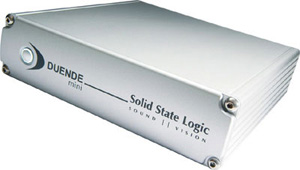 Its original inception as a 1RU FireWire DSP box with a couple of SSL plug-ins has expanded beyond basic emulations and provides more powerful DSP to boot. SSL listened to their user base who wanted the power of the Duende in a more portable package, and they delivered.
Its original inception as a 1RU FireWire DSP box with a couple of SSL plug-ins has expanded beyond basic emulations and provides more powerful DSP to boot. SSL listened to their user base who wanted the power of the Duende in a more portable package, and they delivered.
From the pro who wants some extra horsepower with that distinctive British tone to the hobbyist/prosumer looking to add something classic to their mixes without breaking the bank, the Duende Mini gives a working engineer flexible tools to make great sounding mixes in their favorite DAW while being small enough to be truly portable.
Out of the box, Duende Mini gives you 16 mono (or 8 stereo) instances of the SSL Channel Strip. There are a few paid upgrades, which give you more instances, which I’ll lay out in detail shortly. It should be noted first and foremost that the channel strip and G Buss Compressor are based on the digital C Series console’s channel strip NOT a direct emulation of the 4000G+ channel strip (look to the Waves SSL Bundle for the official emulation of this, or UAD for the unofficial one). Mind you, their intention for the C series was to emulate the 4000 E and G Series EQ’s and channel strips, so it’s not as if this is false advertising.
As someone who has used SSL’s a lot (mostly the 4000 series), I can say with confidence Duende’s sound is DECIDEDLY SSL. The channel strip has done great justice to its legacy, and to my ears, has brought one of my favorite channel strips into the digital realm with benefits. It has retained its well-known functionality and characteristics sonically, and via their X-Series plug-ins, they are not resting on their laurels.
These plug-ins bring new sonic capabilities by creating digital hybrids of both their advanced hardware and software capabilities and then adding routing and unique metering to the mix.
My friend and fellow engineer Will Hensley and I tested the Duende Mini on a few Mac system configurations, from Tiger up to Snow Leopard to test its might. Our test results would most certainly be cross platform, however.
At this point in its product life, Duende has two software versions: V2, for G4/G5 processors using OS X 10.4, and V3 for Intelbased Macs. V2 requires a paid upgrade of $370 to bump it up to 32 channels. V3 starts at 32 instances and allows for even more instances with paid upgrades allowing 64 and 128 channels cost $119 and $229, respectively. The most significant addition to V3 is what SSL calls “hybrid core processing engine.”
What this means to you: V3, once it goes beyond 32 channels, allows the processing to be shared between the host’s processor and Duende’s DSP chips, giving you many more instances of the plugins than just the DSP alone.
You might ask, doesn’t sharing processing defeat the purpose of having an external DSP box? Well, it’s easy to say that looking at a list of specs, but in practice (and certainly in my experiences with digital audio), this is not the case. The light load that the CPU takes doesn’t really compare to the extra processing you’re getting out of the DSP of the Duende. Furthermore, having a set number of plug-in instances on the Duende is a limitation you can count on, unlike native plug-ins which you can add until you just run out of CPU.
This might sound unorthodox at first, but I personally prefer some sort of set limits in all realms of creativity, forcing you to make more definitive choices.
In my experience with these Duende plug-ins, I end up using fewer plug-ins because I’m getting the sound I want quickly, a characteristic that I would generally attribute to using hardware. The channel strip alone makes the Duende a worthwhile purchase in this respect. Hell, even the EQ alone makes it worth it! [See/hear snare demo below.]
Which brings me to the meat and potatoes of our sonic snack, the plugins.
Maybe you’re not nearly as obsessed as I am with plug-ins, but I have seen, used, abused, loved and hated a LOT of plug-ins over the past 10 years. Some of them try to emulate your favorite gear, some of them claim to be the answer to all your problems, and most of them downright suck. To be fair, it’s not that these plug-ins suck, per se, it’s that they don’t get you as far as you want towards sculpting your sound, which then forces you to use more of something else. Sort of like using a spice that doesn’t taste like much of anything unless you put a ton of it on your meal.
EQs are particularly guilty of this inefficacy in the digital realm. I have found very few EQs that do anything for me in terms of character in-the-box and usually end up chaining an EQ either before or after some sort of saturation/distortion for flavor.
The strongest parts of the entire Duende plug-in suite, to me, are the EQ and the rest of the Channel Strip. Aside from their distinctive character, what really makes these EQs shine is the ability to REALLY boost and REALLY cut without ruining your source audio, an attribute that is most evident in the ability to boost the high-mid and high frequencies.
My favorite instance of extreme EQ is when working with electric guitars. I have spent countless hours doing my best to balance out the mids and highs of electric guitars — which sometimes requires multiple bussings — to get exactly what I want out of them. Even just using the channel strip for its dynamics and EQ section, I was always able to dial up something that I found pleasant without having to pull for another insert. [As demo’d below…]
One example, which truly shows the strength of these EQ’s is when dealing with a dry, unprocessed snare sample. With the ability to extremely boost or cut the mids and highs without sounding even remotely harsh, you could get the definition, clarity, and snap of a really up-front and crisp snare top and bottom without using anything other than EQ.
An unsung hero of the channel strip is the gate, a well loved part of the SSL classic consoles. On a noisy bass or toms, these are just the ticket for making things sound cleaner, punchier, and allowing for more extreme EQing while keeping the noisy stuff out your way [hear in demo below]. I find that these gates respond very similarly to the way they do on a G+.
One thing I can also never get enough of in the box is a good way to bring pleasant harmonic distortion into my mix. I was pleased to find that I could drive the input of the channel strip in order to add a little more mojo to, well, just about anything! It did a number on guitars, bass, snare, toms, vocals…you name it. It definitely has the stuff to give a helping of attitude to something that doesn’t feel like it has enough, especially in conjunction with the channel compressors.
I loved the channel compressors on drums, overheads, acoustic and electric guitars, and vocals. It is truly an indispensable tool for crafting audio.
As I mentioned earlier, it allows me to get a lot done with only one plug-in, preventing the need to chain 5 or more plug-ins to get that “je ne sais quoi.” [Bass & Drum Buss demo’d below]
Having fully put the channel strip through its paces, I felt confident digging into the other plug-ins in this suite…
Generally, the first thing that comes to mind when anyone thinks SSL is the G Buss compressor, and for good reason: it has mythical properties, which make things gel in a way that only it can do. I have the Alan Smart C1 (the G buss compressor designer’s namesake), which is strapped across my master buss on every mix I do — in or out of the box. It has served me well for years, but I have MANY times wanted more than one of them, and with Duende, I don’t have to hold back!
Having used the real thing for years, and my Smart C1 for many more, I can say wholeheartedly that they have this piece of hardware nailed. When you want attitude, the plug provides the smack of the hardware G and also does wonderful pumping and breathing on drums and bass, either separately or as a parallel compressor. It’s not the first compressor that comes to mind for this, but it can also work quite well on heavy guitar busses. It can take the low-end heavy guitars of modern rock and tighten them right up, giving them presence and snappy attack on the bottom.
X-SERIES PLUG-INS
Since its release, the newest parts of the Duende, aside from its extra horsepower, are the X Series plug-ins and two plugs for the two trickiest situations: Vocalstrip and Drumstrip. Drumstrip, my favorite of the new offerings, is just a bunch of SSL mojo jammed into one plug-in window.
You’ve got a gate, a transient shaper, HF and LF enhancer, and the famous Listen Mic Compressor. They’re all fabulous tools on their own, but chain them all together…oh yeah!
As a test for the plug-in and myself, I decided to take a raw kick drum from a session I recently tracked for the upcoming Lily and the Parlour Tricks album, and see if I couldn’t just get it to hit like a modern kick drum without samples or any other signals. First I gated the kick, and then I used the transient shaper to give it more attack.
Then, I took both the HF and LF enhancers and cranked ‘em, and also cranked the drive on both of them. This was starting to get really good when finally, I used the Listen Mic Compressor and slammed that really hard. The EQ In button on this makes all the difference in the world; definitely try both to see what suits you best. I blended the wet/dry of the LMC and for an extra lift, drove the input of the entire plug-in. Then I took back the master wet/dry of the plug-in, and set to taste along with the rest of the kit.
Before I knew it, I had a kick drum that really hit hard, without hitting one more plug. [See/hear below]
As exciting as this is, however, I didn’t find myself using it over entire drum kits. In that respect, Drumstrip works wonders on breathing life into drum loops by really allowing you to do a lot of damage (or repair) in one window. The ability to rearrange the signal flow any of these tools within Drumstrip is the BEST part.
The vocal strip, paradoxically, is both exactly what you think it would be and then not at all. It has most of the things you’d expect a vocal chain to have (de-esser, EQ) as well as a couple of interesting SSL versions of things (compander, deploser). We didn’t find it to be entirely intuitive on our initial uses, but I could see it having its purpose in plenty of situations. As a full on vocal chain, however, I’d have to respectfully decline. There are plenty of other solutions both native and otherwise that can do these jobs with a lot less confusion.
The De-Esser works in a way that frustrated both Will and I, and the EQ isn’t anything to write home about. The way that it works seems to make sense, but we felt every time we tried to use the EQ, it would work against us. The de-ploser could have its uses, but isn’t worth the price of the whole plug-in.
The flow of this plug-in, unlike all the others in this bundle, escapes me. We tried a number of times to love it, but in the end it was the most disappointing part of the entire SSL offering.
The X-Verb is the last of these offerings, and although it is much more intuitive than some reverbs in its layout, I believe its greatest asset to be that it is a good sounding reverb that doesn’t put a hit on your CPU. This can be a lifesaver in a heavy tracking session when it’s time to do vocals and you want a nice plate for the vocalist to really catch a vibe.
I won’t go so far to say these reverbs are going to replace any high-end reverbs, but they do the job and certainly don’t sound cheap. Its decay didn’t sound digital, and without much effort, you could have a nice plate or hall that sits in a mix quite nicely.
TECH: STABILITY & USEFULNESS
The last thing I’ll cover might be the most important part of using the Duende (or any external processing box/cards). The stability and usefulness of any plug-in and/or software based audio gear are going to be dependent on your current system and anything installed on it. For instance, its integration with Pro Tools requires that the plug-ins are wrapped, meaning they’re not natively RTAS. This requirement could create problems with other plug-ins.
Another major thing to consider is that Duende functions on FireWire, and it REALLY prefers to be on its own FireWire bus. I highly suggest giving it carte blanche of FireWire and running your session off of E-SATA if possible.
Duende also prefers certain buffer settings depending on how large and intense your session is. These things are all documented well in SSL’s FAQ’s and most problems can be solved very easily.
I’d say the biggest issue we ran into was using the Duende in conjunction with TDM plug-ins and lots of submixing in the box, which, depending on the buffer settings, can create some unusable delay compensation situations. To be fair, this issue can come up with any RTAS or non-TDM plug-in. However, the Duende can be very specific at times with buffer settings, which can create popping and clicking sounds.
Overall, once you’ve got a feel for how the Duende works on your system, it runs quite well and can give your computer a nice performance boost. I think this is best suited for native DAWs, however.
SUMMARY
In closing, I think that for many systems, the Duende will give you both a power boost and a boatload of analog character for not a lot of money. Even if you purchase it solely for the channel strips, I think it is well worth its ability to bring new colors and flexibility into your mixing and tracking worlds.
The added bonus of being small and very portable (not to mention sharp-looking) put this device on a short list of purchases, which — aside from going to a TDM setup —can bring some welcome horsepower to your rig.
SSL has done a great job of continuing their legacy into the world of digital and making it very accessible to both budding professionals and hobbyists alike.
Tommy Mokas is a musician, writer, engineer/producer and co-owner of Casa Nova Studios in Williamsburg, Brooklyn. He plays in the bands The Dirty Pearls, The Bleeding Bombshells and fronts the band Nova Clutch. He has engineered and/or produced for artists including Earl Greyhound, The London Souls, Lily and the Parlour Tricks, The Exit, and many more. He also frequently composes music for both artists and corporate clients with his partner in crime, Nick Rosenthal.
Will Hensley is an engineer who’s worked with artists such as John Mayer, Doves, Coldplay and Ben Folds.
Please note: When you buy products through links on this page, we may earn an affiliate commission.







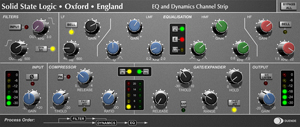
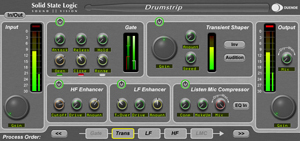
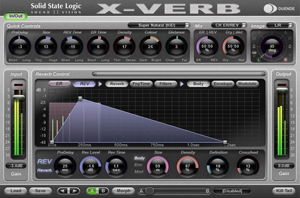
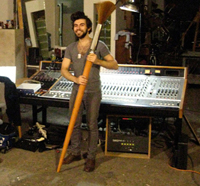
mjfe2
September 5, 2012 at 5:41 am (12 years ago)‘I was pleased to find that I could drive the input of the channel strip
in order to add a little more mojo to, well, just about anything! It did
a number on guitars, bass, snare, toms, vocals…you name it. It
definitely has the stuff to give a helping of attitude to something that
doesn’t feel like it has enough, especially in conjunction with the
channel compressors.’
Just to say, the Channel Strip definitely doesn’t saturate if you push it. I’ve overloaded it into the red and then made it null with the same track minus the plugin. SSL’s philosophy is definitely not to add harmonic distortion (you can get this easily from loads of freeware) but rather to make things clean and musical. Even with the compressor engaged I don’t think they purposely added distortion. Otherwise, I agree with your review about how musical the EQ is!